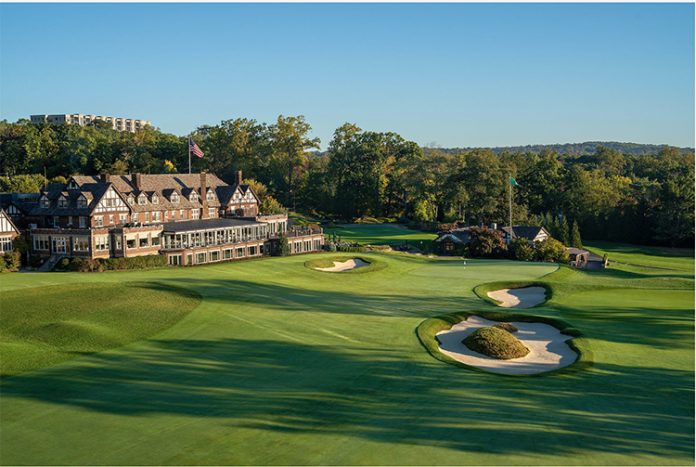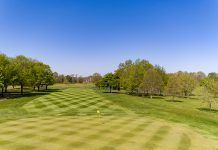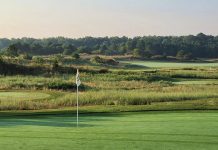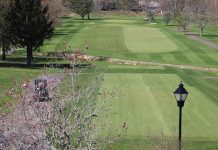A multi-year restoration of the Upper Course at Baltusrol Golf Club, led by renowned golf course architect Gil Hanse, is now complete.
Originally designed by A.W. Tillinghast, the Upper Course opened in 2021 as part of Baltusrol’s historic “Dual Courses” initiative, the first contiguous design and build of 36 holes in the United States. The Lower Course, also designed by Tillinghast and restored by Hanse, reopened in 2021, and is slated to host the 2029 PGA Championship. The two different, yet equal courses have been a mainstay of championship golf since 1901, including being the only golf club in America to have hosted both the Men’s and Women’s U.S. Open Championships on both of its golf courses.
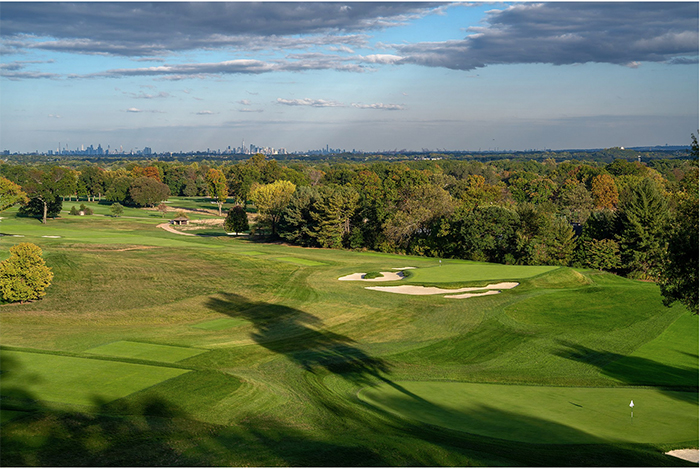
Upper Course #15
Hanse was retained in 2018 to help prepare a long-range master plan that included both golf courses, with particular attention to restoring Tillinghast’s design features and shot values. Having undergone numerous revisions, large and small, in their century-long existence, the club wanted to return the purity of Tillinghast’s original concepts to both courses.
“We are confident that by restoring the Lower and Upper Courses to Tillinghast’s original vision, we have positioned the Club to ensure its place in golf history and created golf courses that members and guests of all skill levels will enjoy playing for many years to come,” said Matt Wirths, Master Plan Committee Co-Chairman.
Armed with a large collection of historical documents—primarily aerial photographs—Hanse and his associates examined the Upper Course hole by hole, noting where changes over the years had minimized what was originally Tillinghast or had given modern equipment an unfair advantage.

Upper Course #4
“It became apparent through the features, character, topography, and the views, that the setting of the Upper is a much more natural golf course than the Lower,” said Hanse. “The features are really interesting, and because the topography allowed it to happen, some are bolder, especially the opening set of greens.”
Changes were made to every hole. Teeing areas on the Upper Course have increased by 50,000 square feet, with expanded teeing options—including the addition of new forward tees—allowing golfers to enjoy the course from multiple distances. The Upper Course greens were expanded by over 65% to nearly 165,000 square feet. (By comparison, the Lower Course greens increased by 22% to 155,000 square feet.)

Lower Course #4
According to Hanse, restoring the greens to their original size and scale created “more fun hole locations” and makes play “more interesting.” And the two-green complex on hole 14, an original Tillinghast feature that had disappeared over the years, was recreated.
Critical to maintaining the character of Baltusrol’s courses is the preservation of the “subtleties” of the greens, as well as retaining the turf grass native to the micro-climate of these two courses. The existing “push-up greens” were initially shaped with native soil. The new greens, built to USGA specifications, provide the grounds team greater control to manage moisture levels and maintain firmer conditions throughout the season. 3D computer modeling was used to create laser scans of the greens before, during, and after construction., and after construction.
The removal of trees around the course enlarged the field of play and re-established the beauty and scale of views. Some fairways were widened, and length was added to several holes as were forward tees.

Lower Course #18
New native areas have been introduced to increase the amount of natural habitat, reduce the amount of acreage that needs maintenance, and, says Hanse, “create a different texture through the entire landscape.” As for bunkers, “Every single one of them was reshaped and rebuilt in the locations Tillinghast envisioned where appropriate, and also in the style that Tillinghast presented.”
“I think because of the scale of the topography, Tillinghast was emboldened to build bigger features, bigger bunkers, bigger everything, and it sat in the land a little bit better,” Hanse said.
Out of sight, the course infrastructure was updated with new irrigation and a subterranean PrecisionAire system to make conditions more predictable, with the course able to dry faster and present better, healthier turf. These infrastructure improvements are critical for the agronomics to match Tillinghast’s design intent of being fast and firm. New software provides the Club’s grounds crew with real-time data, including air velocity and air temperatures moving through the units, as well as the ability to control each unit remotely.
“I think Baltusrol can stand toe to toe with any 36-hole complex in this country,” Hanse stated. “It’s the variety. It’s the difference, and the fact that the Lower Course is situated on the lower section of the property, and the Upper has some amazing topography. I think both now have a consistency as it relates to Tillinghast in his design and the way he presented and visualized those golf courses.”
The National Historic Landmark plaque on display in the clubhouse sums it up: The Lower and Upper Courses at Baltusrol Golf Club, created between 1918 and 1924, form the seminal work of designer A.W. Tillinghast. It is here that he established his principles of golf course architecture and “the course beautiful,” providing golfers with a strategic test set within a naturalistic landscape.



